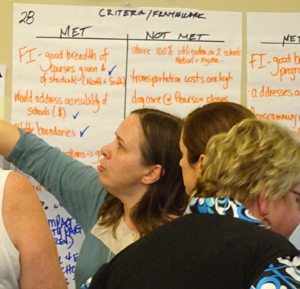March 22, 2017
BURLINGTON, ON
Quantitative? Qualitative?
How many people responded to the survey and was there balance in the responses.
Tuesday evening the PAR Committee members were given a briefing on what the 1611 people who completed the on-line survey had to say about the six options to close high schools that were on the table.
The details on that survey were published as a separate article.
This PARC has had difficulty with getting good data and pulling information from that data that can be used to determine the best direction.
The process the province put in place to involve parents is now seen as deficient. It is new and will no doubt be changed but the PAR committee has to work with what they have been given.
The chair of the PARC appears to b ready to loosen things up a little. Scott Podrebarac, a Superintendent with the Board, is running meetings under a process that is new – he is sort of learning what to do each meeting. Many of the PAR committee members want a more open process.
Last night the public heard the numbers part of the quantitative part of the data. There was a lot of discussion about the value of the data. The number of responders was small and it was a complex survey with the average time spent by those who completed it amounting to 21 minutes. The Board did no report on the number of people who did not complete the survey.
The qualitative aspect wasn’t discussed on Tuesday. There were tens of thousands in the way of comments. How do they get tens of thousands of comments from 1600 + responses? There could have been as many as seven comments from each person (7 x 1611 = 11,277) and the PAR committee wanted to see every one of them.
There is a significant level of distrust between the Board staff and some members of the PARC. They are complaining about the quality of much of the information they are being given and unhappy with the Terms of Reference they have been asked to work within.
Some members of the PARC feel the Board staff will present just those comments that support their option – which was to close two of the seven high schools.
Board staff talked about privacy issues in releasing all the comments. Blank out anything that identifies anyone responded those PARC members who are unhappy with the way Board staff have been managing the flow of information.
It has taken the 14 PARC members time to begin to work as a group – almost from the beginning the PARC members spent their time and energy defending their schools. When it became evident that both Nelson and Bateman were being considered for closure their representatives became very vocal.
The committee began to feel that the Board staff had them working against each other to save their school when what many of them wanted to do was find a solution that could keep all the schools open
The parents wanted to be part of a process that was going to look for a solution and they felt they weren’t being allowed to do that.

Lynn Crosby didn’t want to miss a word that was said. It was difficult at times to hear what the PARC members were saying
There might have been a bit of a change in the way the Board is managing this process. The trustees are meeting this evening – Wednesday and are expected to add additional meeting time for the PARC members to deliberate.
There is quite a bit more to take place – the real leaders should become more evident very soon.
And everyone is waiting to see what those tens of thousands of comments actually say.



















It has been evident for some time that the PARC process is broken – so fix it.
Giving the PARC members additional time, time they deem sufficient, seems to be a good start to a fix.
They need time for what they have learned to simmer, and time to produce details of what they want to see done, and ways how.
This creative process needs time to emerge. They need time to see if they can reach consensus.
The Board is not trusted to do this, but they have to facilitate something workable to emerge from the PARC – the Board are a big part of the problem.
The public survey is not a statistically valid sample you can use to make valid inferences that certain summary statistical responses reflect the population preferences with the usual 95% confidence.
The questions impose a structure that also impose a structure on the responses.
The population sampling frame was open to anyone – not a random sample.
The respondents are all self-selected and biased.
The results are grossly indicative of what the aggregate of the individual preferences might reveal of patterns that may emerge of what the integrated responses are showing.
The number of comments depends on how many each respondent wanted to make in each of the seven questions – there was no limit in each.
I agree that the most interesting insights will come from the comments.
These comments allow the respondents to expressed their own unfettered judgments and opinions of what they think and want.
These are not constrained in form by the questionnaire.